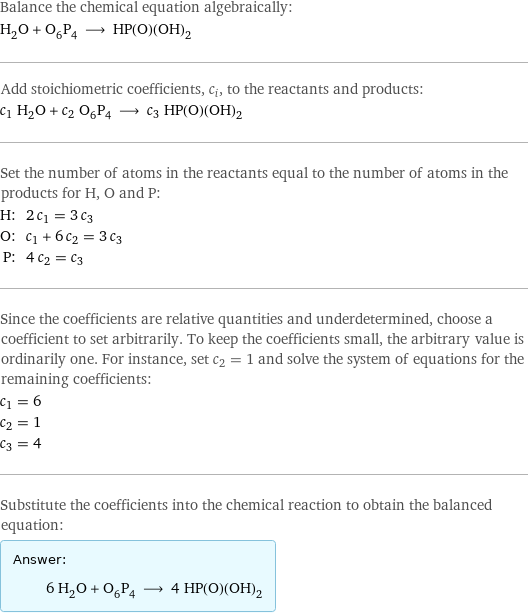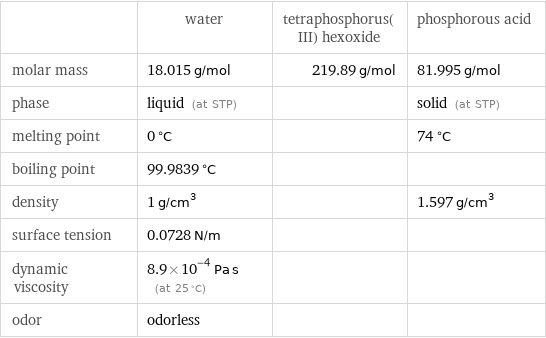Input interpretation

H_2O water + O_6P_4 tetraphosphorus(III) hexoxide ⟶ HP(O)(OH)_2 phosphorous acid
Balanced equation

Balance the chemical equation algebraically: H_2O + O_6P_4 ⟶ HP(O)(OH)_2 Add stoichiometric coefficients, c_i, to the reactants and products: c_1 H_2O + c_2 O_6P_4 ⟶ c_3 HP(O)(OH)_2 Set the number of atoms in the reactants equal to the number of atoms in the products for H, O and P: H: | 2 c_1 = 3 c_3 O: | c_1 + 6 c_2 = 3 c_3 P: | 4 c_2 = c_3 Since the coefficients are relative quantities and underdetermined, choose a coefficient to set arbitrarily. To keep the coefficients small, the arbitrary value is ordinarily one. For instance, set c_2 = 1 and solve the system of equations for the remaining coefficients: c_1 = 6 c_2 = 1 c_3 = 4 Substitute the coefficients into the chemical reaction to obtain the balanced equation: Answer: | | 6 H_2O + O_6P_4 ⟶ 4 HP(O)(OH)_2
Structures

+ ⟶
Names

water + tetraphosphorus(III) hexoxide ⟶ phosphorous acid
Equilibrium constant
![Construct the equilibrium constant, K, expression for: H_2O + O_6P_4 ⟶ HP(O)(OH)_2 Plan: • Balance the chemical equation. • Determine the stoichiometric numbers. • Assemble the activity expression for each chemical species. • Use the activity expressions to build the equilibrium constant expression. Write the balanced chemical equation: 6 H_2O + O_6P_4 ⟶ 4 HP(O)(OH)_2 Assign stoichiometric numbers, ν_i, using the stoichiometric coefficients, c_i, from the balanced chemical equation in the following manner: ν_i = -c_i for reactants and ν_i = c_i for products: chemical species | c_i | ν_i H_2O | 6 | -6 O_6P_4 | 1 | -1 HP(O)(OH)_2 | 4 | 4 Assemble the activity expressions accounting for the state of matter and ν_i: chemical species | c_i | ν_i | activity expression H_2O | 6 | -6 | ([H2O])^(-6) O_6P_4 | 1 | -1 | ([O6P4])^(-1) HP(O)(OH)_2 | 4 | 4 | ([HP(O)(OH)2])^4 The equilibrium constant symbol in the concentration basis is: K_c Mulitply the activity expressions to arrive at the K_c expression: Answer: | | K_c = ([H2O])^(-6) ([O6P4])^(-1) ([HP(O)(OH)2])^4 = ([HP(O)(OH)2])^4/(([H2O])^6 [O6P4])](../image_source/0a5ba755fdd4773482511a92112c0923.png)
Construct the equilibrium constant, K, expression for: H_2O + O_6P_4 ⟶ HP(O)(OH)_2 Plan: • Balance the chemical equation. • Determine the stoichiometric numbers. • Assemble the activity expression for each chemical species. • Use the activity expressions to build the equilibrium constant expression. Write the balanced chemical equation: 6 H_2O + O_6P_4 ⟶ 4 HP(O)(OH)_2 Assign stoichiometric numbers, ν_i, using the stoichiometric coefficients, c_i, from the balanced chemical equation in the following manner: ν_i = -c_i for reactants and ν_i = c_i for products: chemical species | c_i | ν_i H_2O | 6 | -6 O_6P_4 | 1 | -1 HP(O)(OH)_2 | 4 | 4 Assemble the activity expressions accounting for the state of matter and ν_i: chemical species | c_i | ν_i | activity expression H_2O | 6 | -6 | ([H2O])^(-6) O_6P_4 | 1 | -1 | ([O6P4])^(-1) HP(O)(OH)_2 | 4 | 4 | ([HP(O)(OH)2])^4 The equilibrium constant symbol in the concentration basis is: K_c Mulitply the activity expressions to arrive at the K_c expression: Answer: | | K_c = ([H2O])^(-6) ([O6P4])^(-1) ([HP(O)(OH)2])^4 = ([HP(O)(OH)2])^4/(([H2O])^6 [O6P4])
Rate of reaction
![Construct the rate of reaction expression for: H_2O + O_6P_4 ⟶ HP(O)(OH)_2 Plan: • Balance the chemical equation. • Determine the stoichiometric numbers. • Assemble the rate term for each chemical species. • Write the rate of reaction expression. Write the balanced chemical equation: 6 H_2O + O_6P_4 ⟶ 4 HP(O)(OH)_2 Assign stoichiometric numbers, ν_i, using the stoichiometric coefficients, c_i, from the balanced chemical equation in the following manner: ν_i = -c_i for reactants and ν_i = c_i for products: chemical species | c_i | ν_i H_2O | 6 | -6 O_6P_4 | 1 | -1 HP(O)(OH)_2 | 4 | 4 The rate term for each chemical species, B_i, is 1/ν_i(Δ[B_i])/(Δt) where [B_i] is the amount concentration and t is time: chemical species | c_i | ν_i | rate term H_2O | 6 | -6 | -1/6 (Δ[H2O])/(Δt) O_6P_4 | 1 | -1 | -(Δ[O6P4])/(Δt) HP(O)(OH)_2 | 4 | 4 | 1/4 (Δ[HP(O)(OH)2])/(Δt) (for infinitesimal rate of change, replace Δ with d) Set the rate terms equal to each other to arrive at the rate expression: Answer: | | rate = -1/6 (Δ[H2O])/(Δt) = -(Δ[O6P4])/(Δt) = 1/4 (Δ[HP(O)(OH)2])/(Δt) (assuming constant volume and no accumulation of intermediates or side products)](../image_source/9a15e777485a81e76ba854e518013380.png)
Construct the rate of reaction expression for: H_2O + O_6P_4 ⟶ HP(O)(OH)_2 Plan: • Balance the chemical equation. • Determine the stoichiometric numbers. • Assemble the rate term for each chemical species. • Write the rate of reaction expression. Write the balanced chemical equation: 6 H_2O + O_6P_4 ⟶ 4 HP(O)(OH)_2 Assign stoichiometric numbers, ν_i, using the stoichiometric coefficients, c_i, from the balanced chemical equation in the following manner: ν_i = -c_i for reactants and ν_i = c_i for products: chemical species | c_i | ν_i H_2O | 6 | -6 O_6P_4 | 1 | -1 HP(O)(OH)_2 | 4 | 4 The rate term for each chemical species, B_i, is 1/ν_i(Δ[B_i])/(Δt) where [B_i] is the amount concentration and t is time: chemical species | c_i | ν_i | rate term H_2O | 6 | -6 | -1/6 (Δ[H2O])/(Δt) O_6P_4 | 1 | -1 | -(Δ[O6P4])/(Δt) HP(O)(OH)_2 | 4 | 4 | 1/4 (Δ[HP(O)(OH)2])/(Δt) (for infinitesimal rate of change, replace Δ with d) Set the rate terms equal to each other to arrive at the rate expression: Answer: | | rate = -1/6 (Δ[H2O])/(Δt) = -(Δ[O6P4])/(Δt) = 1/4 (Δ[HP(O)(OH)2])/(Δt) (assuming constant volume and no accumulation of intermediates or side products)
Chemical names and formulas

| water | tetraphosphorus(III) hexoxide | phosphorous acid formula | H_2O | O_6P_4 | HP(O)(OH)_2 Hill formula | H_2O | O_6P_4 | H_3O_3P name | water | tetraphosphorus(III) hexoxide | phosphorous acid
Substance properties

| water | tetraphosphorus(III) hexoxide | phosphorous acid molar mass | 18.015 g/mol | 219.89 g/mol | 81.995 g/mol phase | liquid (at STP) | | solid (at STP) melting point | 0 °C | | 74 °C boiling point | 99.9839 °C | | density | 1 g/cm^3 | | 1.597 g/cm^3 surface tension | 0.0728 N/m | | dynamic viscosity | 8.9×10^-4 Pa s (at 25 °C) | | odor | odorless | |
Units
